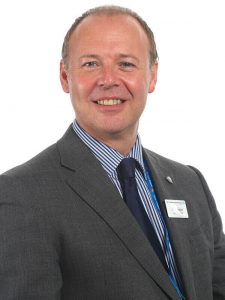2 November 2017
Shropshire’s two acute hospitals are taking steps to ensure patients continue to receive the best care possible as winter begins to take hold.

Simon Wright Chief Executive
The Royal Shrewsbury Hospital (RSH) and the Princess Royal Hospital (PRH) in Telford are already seeing large numbers of people presenting at A&E with conditions related to colder weather, such as respiratory problems.
But The Shrewsbury and Telford Hospital NHS Trust (SaTH) which runs the two hospitals has put a number of measures in place to help tackle what is traditionally the busiest time of the year for the NHS.
The Trust has recently appointed a new locum A&E Consultant who will be based at PRH, taking the number of Consultants across the two A&Es to nine for the first time in a number of years.
A Clinical Decision Unit (CDU) has also been opened at PRH. The CDU is for patients who don’t need to be admitted to hospital, but do need to be at the hospital for more than four hours to have treatments completed or observations taken over a period of time to make sure they are well enough to return home.
Working with colleagues from Telford & Wrekin Clinical Commissioning Group (CCG), SaTH has also opened an Urgent Care Centre (UCC) at PRH. The UCC, next to A&E, opened on Saturday and is seeing patients with minor ailments and problems that don’t need the expertise of staff in the Emergency Department. It is open from 10am-10pm daily and is manned by a GPs and Urgent Care Practitioners who are very skilled in dealing with minor problems and injuries.
At RSH, a discharge lounge will be opened in the day room on Ward 32 Short Stay on Monday. The discharge lounge, which will be open from 9am to 9pm, seven-days-a-week, is for patients who are ready for discharge and “fit to sit” to use prior to leaving the hospital. This will free-up beds which would otherwise be unavailable.
Simon Wright, Chief Executive of The Shrewsbury and Telford Hospital NHS Trust (SaTH) said: “We have been planning for this winter for a long time and have put in a number of measures to help us cope over this very busy period. On top of this, we are absolutely delighted to have secured the services of an additional locum Consultant in our A&Es.
“Our hospitals have been very busy for a number of weeks, but this week it is beginning to feel like winter has arrived. We are seeing large numbers of people attending our A&Es and also a lot of people presenting with respiratory problems, who need admitting for further treatment.
“In the first three days of this week, we have already seen more than 1,000 people through the doors of our two A&Es.
“This demand means that we are having to use recognised escalation areas. Even with this, some patients with less serious complaints are waiting a long time for treatment.
“Because of this, we would ask people to think carefully about whether a trip to A&E, which could lead to a lengthy wait, is really necessary.
“People suffering from minor illness or injuries can access more appropriate health services, allowing us to focus on those people with serious conditions, who need to be seen urgently.”
Alternative sources of care for non-critical ailments are:
- Local pharmacy – they can provide advice and treat a range of minor illnesses and conditions.
- NHS 111 – Call 111 for free from any phone 24 hours a day 7 days a week, and you can quickly access appropriate health information and advice
- Minor Injuries Units around the county can treat a range of minor conditions without the need to travel to an A&E department
- You can also book urgent appointments at GP practices, often for the same day or if you are poorly out of normal working hours, you can call Shropdoc the GP Out-of-Hours service on 0333 222 66 55.
Simon said: “Many conditions can be seen much more quickly using alternative services and A&E should only be used for the most serious injuries and illnesses.
“We established the NHS Future Fit programme to get a solution to these issues. Under those plans, a single specialised Emergency Department, which would be 50% larger than our current small A&Es, would be established which would provide treatment only to the most serious emergencies. Most people who currently attend our A&Es would be treated at Urgent Care Centres at our two hospitals.
“This development would significantly improve the experience for patients who currently use our A&Es and we look forward to these plans going out to public consultation in the very near future.”
For more information about alternatives to A&E visit: www.sath.nhs.uk/wards-services/urgent
